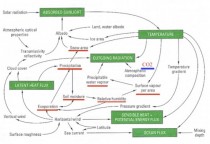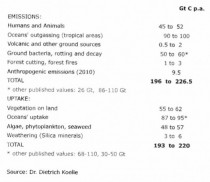By Roger Harrabin, BBC News
Several environmentalists, UK MPs and scientists has called for the resignation of Rajendra Pachauri, chair of the UN’s climate science body.
Dr Pachauri, head of the Intergovernmental Panel on Climate Change (IPCC) has in the past been criticised by climate “sceptics”.
They have claimed that some of his comments had become politicised.
Pressure increased recently when a report recommended that IPCC chairs serve only a single term of office.
Dr Pachauri has yet to comment on the matter. The IPCC chair is into his second term and several leading scientists and green thinkers contacted by BBC News say he should quit now.
The list includes Tim Yeo, chairman of the all-party Commons Climate and Energy Committee and Mike Hulme a former IPCC lead author. Mr Yeo told BBC News: “Dr Pachauri has become a liability - he is now causing more harm than good. Climate science needs a guarantee of utmost reliability, and Dr Pachauri can no longer guarantee that. It would be as well if he stepped aside.” Professor Hulme said: “Whatever merit his leadership of IPCC has had in the past, Dr Pachauri is unfortunately now associated with controversy and error in the IPCC AR4.” “As clearly implied by the IAC Review, a new chair for AR5 would bring fresh vitality and a new respect to the IPCC.”
The IPCC has admitted it made a mistake in its 2007 assessment - known as AR4 - in asserting that Himalayan glaciers could disappear by 2035. But it says this error did not change the broad picture of man-made climate change.
The chairman’s fate will be decided by a meeting of the IPCC in South Korea next month. BBC News understands that the government representatives overseeing the IPCC are reluctant to oust him for fear of upsetting India - a major player in climate talks and a growing superpower.
‘Losing face’
The UK government told BBC News that it was not explicit in the IAC report that a current chair of the IPCC should resign before the current assessment report is finished. But Professor Brian Hoskins, a Royal Society Fellow who reviewed the IAC report, said that speedy resignation was the obvious intention of the IAC. “The IAC recommendation is subtle,” he said. “But it probably would be better for the future of the IPCC if Dr Pachauri were to resign of his own accord, taking great care to ensure that there is no question of India losing face as India is such a major country for mitigation (of emissions) and adaptation (to climate change).”
Most other commentators contacted by BBC News shared the view that the IAC intended Professor Pachauri to leave now rather than wait until the end of his term. Most hoped that he would choose to resign in accordance with the IAC report and forestall any diplomatic row.
Fred Pearce, veteran environment author for New Scientist: “I do not normally favour calling for people to resign. But in this case it is obvious that the IAC intends Pachauri to go, even though it’s not explicit. So it may not be entirely fair, but for the sake of the IPCC it would be better if he resigns.”
Geoffrey Lean, the long-serving environment correspondent, now on the Daily Telegraph: “The time passed some while ago in which Pauchari ceased to be an asset to the IPCC and became a liability.”
The UK director of Greenpeace John Sauven told The Times in February: “The IPCC needs to regain credibility. Is that going to happen with Pachauri [as chairman]? I don’t think so. We need someone held in high regard who has extremely good judgment and is seen by the global public as someone on their side.” I understand this is still his view, although he has been discouraged by Greenpeace International from taking a stance on the issue.
Fixed term
Of all the commentators contacted by BBC News only former government adviser Tom Burke insisted that Dr Pachauri should serve out his full term. “It’s important not to give a trophy to sceptics,” he said. “Pachauri has not done a very good job and should not have been appointed for a second term,” he said. “But he’s here now and should finish the job (of AR5 - the IPCC’s next climate assessment).”
Tony Juniper, former head of Friends of the Earth said: “It is very important that this is handled sensitively and that any impression of faults with climate science are avoided. “But it is probably best for the IPCC if the current chair ponders on his very considerable achievements and decides of his own accord to pass the baton to someone else to complete the work on AR5. It seems clear to me that this is what the Inter Academy Council intended.”
George Monbiot has angrily refuted allegations in right-wing newspapers that Dr Pachauri has profiteered from his IPCC office. But he also called on the IPCC chair to resign to protect the reputation of the UN body.
Foremost in the minds of commentators concerned about climate change is the fear that sceptics will use Dr Pachauri’s continued presence on the IPCC to undermine the next report, AR5.
Former Cabinet Secretary Andrew Turnbull was calling for Dr Pachauri’s resignation in his foreword to a recent report from the sceptical think-tank, the Global Warming Policy Foundation.
The BBC understands that if Dr Pachauri is determined to hang on to the job, his post is safe for a while at least. A UN source said developed countries were keen to strike a deal on biodiversity, so would not be prepared to upset developing countries by calling for resignation of a high-profile Indian.
The question now is whether Dr Pachauri feels he is still serving the best interests of the IPCC, following such a negative reaction from British greens whom he may have considered to be his friends. Read more here.
By Marlo Lewis, OpenMarket.org
Last Thursday (September 16, 2010), three groups, each led by the Coalition for Responsible Regulation (CRR), filed motions with the D.C. Circuit Court of Appeals to “stay” (put a hold on) the Environmental Protection Agency’s recently finalized greenhouse gas regulations.
The EPA regulations at issue are:
The Endangerment Rule, which finds that greenhouse gas (GHG) emissions endanger public health and welfare, thereby obligating EPA to develop and adopt GHG emission standards for new motor vehicles.
The Tailpipe Rule, which, per the Endangerment Rule, establishes first-ever GHG emission standards for new motor vehicles.
The Triggering Rule, which holds that when the Tailpipe Rule takes effect (Jan. 2, 2011), “major” GHG emitting facilities will be “subject to regulation” under the Act’s Prevention of Significant Deterioration (PSD) pre-construction permitting program and Title V operating permits program.
The Tailoring Rule, which amends the PSD and Title V definitions of “major emitting facility” to avoid the “absurd result” of EPA and State environmental agencies having to process an estimated 41,000 PSD permits and 6.1 million Title V permits every year.
The groups filing the motions are: (1) a coalition of business associations led by the National Association of Manufacturers; (2) the State of Texas; and (3) a coalition of public policy advocates. The industry group is asking the Court to stay the Endangerment Rule, the Triggering Rule, and the Tailoring Rule, although not the Tailpipe Rule. Texas and the advocacy groups ask for a stay on all four regulations pending the Court’s review and decision to uphold or vacate the rules.
One point the motion makes is unarguable. Granting a stay can cause no harm to public health, even if one assumes global warming is a big problem. After all, EPA itself estimates that the Tailpipe Rule - the only rule for which environmental effects are estimated - would avert less than 1/100th of a degree Fahrenheit of global warming by 2100. Thus, if the Tailpipe Rule survives judicial scrutiny, delaying its implementation by six months to a year would have no discernible environmental impact. Besides, the stay would not affect the National Highway Traffic Safety Administration’s (NHTSA) recent revision of fuel economy (CAFE) standards, and the overwhelming lion’s share of emission reductions required by the Tailpipe Rule actually comes from the new fuel economy regulations.
In contrast, the motions argue, EPA’s rules are already harming the economy. The dubious legal basis of both the Tailoring Rule and EPA’s efforts to bully States into immediately amending their permit programs “now impose a terrible uncertainty tax on our struggling economy, as no business is able to make plans or investments in reliance on a regulatory scheme so clearly at odds with the plain language of the Act.” Businesses and State permitting agencies will incur additional losses if they make investments based on EPA’s rules and the rules are subsequently overturned. Best to put the regs on hold until the Court rules on their legal bona fides.
The Competitive Enterprise Institute (CEI) is a party to the advocacy group motion, which makes a powerful case that the regulations should be stayed and, ultimately, overturned. Lest anyone suspect that I’m tooting my own horn, I had absolutely no role in either developing or drafting the motion.
Big Picture
As can be surmised from the description above, EPA’s four rules are interdependent. The Endangerment Rule authorizes and, indeed, compels EPA to establish GHG emission standards for new motor vehicles. The emission standards, promulgated via the Tailpipe Rule, make GHGs subject to regulation under PSD and Title V, according to the Triggering Rule. To avoid administrative paralysis, economic disruption, and political backlash, the Tailoring Rule exempts all but the largest GHG emitters from PSD and Title permitting requirements over the next six years, raising from 100/250 tons per year to 75,000/100,000 tons per year the cutoff for regulation as a “major” emitting facility.
This custer of regulations is a classic case of bureaucratic self-dealing. As discussed elsewhere, EPA has positioned itself to determine the stringency of fuel economy standards for the auto industry, set climate policy for the nation, and even amend provisions of the Clean Air act - powers Congress never delegated to the agency. The Endangerment Rule is both trigger and precedent for sweeping policy changes Congress never approved. America could end up with a pile of greenhouse gas regulations more costly than any climate bill or treaty the Senate has declined to pass or ratify, yet without the people’s representatives ever voting on it. Overturning EPA’s GHG rules is a constitutional imperative.
The Arguments
The motion to stay advances new arguments - or improved versions of familiar arguments - for overturning each of the four EPA rules. The following sections summarize and excerpt some of the motion’s key insights.
EPA Outsourced Its Endangerment Judgment
Section 202 of the Clean Air Act requires the Administrator to determine the dangerousness of air pollution from motor vehicles based on her “judgment”.
Instead, the motion points out, quoting EPA’s Endangerment Rule:
“the Administrator ...rel[ied] on the major assessments of USGCRP, IPCC and NRC as the primary scientific and technical basis of her endangerment decision.” 74 Fed. Reg. at 66,510.14
EPA specifically declined to undertake “a new and independent assessment,” id. at 66,511, preferring to “plac[e] primary and significant weight on these assessment reports in making her decision on endangerment.” Id.
Which means:
. . . the only “judgment” EPA really made is that IPCC can be trusted to have made the endangerment assessment required by the Act. But the Act does not authorize entities other than EPA to make that assessment. See, e.g., U.S. Telecom Ass’n v. FCC, 359 F.3d 554, 565 (D.C. Cir. 2004) ("[F]ederal agency officials...may not subdelegate to outside entities - private or sovereign - absent affirmative evidence of authority to do so.").
In effect, EPA asks the Court and the American people to trust that the IPCC did its job objectively, adhering to U.S. Government standards of scientific integrity. “But neither this Court nor the interested public can determine whether IPCC in fact did so, because the innumerable choices made by its many authors are not in the record.” The Climategate emails reveal instances of behavior inconsistent with U.S. information quality standards, such as Climatic Research Unit Director Phil Jones vowing to keep peer-reviewed research contrary to his views out of the next IPCC report “even if we have to redefine what the peer reviewed literature is.”
Bottom line: The Endangerment Rule embodies “a scientific judgment made by IPCC, and then adopted by EPA, not supported by any record that this Court can review. This is error.”
EPA Fails to Make the Judgment Required by Sec. 202
“Endangerment,” the motion observes, “is not a scientific term with defined endpoints. It is not an objective measure, like the boiling point of water, but a value judgment, like ‘bad.’ And so before EPA finds ‘endangerment,’ it first must define it.” In other words, EPA must explain its judgment in terms of climate-related metrics like temperature, precipitation, or wind speed, such that the public can understand which changes in climatic variables constitute endangerment, and which do not. “EPA has failed to do so.”
To clarify this point, the motion compares EPA’s endangerment finding for motor vehicle GHG emissions with the agency’s 1973 endangerment finding for vehicular lead emissions. In the earlier rule, EPA provided quantitative information relating lead emissions to atmospheric concentrations, the latter to blood lead levels, and blood levels to brain function. In addition, EPA analyzed how regulation of lead in gasoline would reduce atmospheric concentrations, reduce lead levels in blood, and, thus, improve public health. Thus, “By the end of the rulemaking, EPA had fully explained all of the choices it made along the path of converting available scientific knowledge about lead toxicology and exposure into a policy-based finding of endangerment from automotive lead emissions sufficient to justify regulation, and allow - and survive - judicial review.”
In contrast, EPA “jumps from the tautology that ‘greenhouse gases cause a greenhouse effect’ to ‘greenhouse gases endanger public health and welfare’ sufficient to warrant exactly the level of GHG reductions that happen to result from NHTSA’s imposition of the CAFE standards required by the Energy Policy and Conservation Act.” The motion continues:
It is as though EPA, in Ethyl [Corp. v. EPA, 541 F. 2d1, 1976], were defending a rule to ban leaded gasoline because lead is a poison at some unknown dose; cars burning leaded gasoline can emit lead, which has some unknown effect on atmospheric lead concentrations; and banning leaded gasoline would yield some unknown but trivial reduction in atmospheric lead levels, possibly mitigating by some unknown (but at best trivial) degree the unknown adverse effects that may result from atmospheric lead, although it is very, very possible that the ban would accomplish absolutely nothing at all.
“If anything,” the motion comments, “EPA should face a far greater burden to explain its policy choices here than it did in Ethyl. Lead is strictly a poison, whereas carbon dioxide is a natural component of clean air, ingested by all plants and exhaled by all animals. Life on Earth depends on the very ‘danger’ that EPA is trying to prevent.” Carbon dioxide is not only plant food, it also helps keep the Earth habitably warm.
In short, “An endangerment finding under Section 202(a) does not simply identify a health and welfare risk, as EPA contends; it also establishes the criteria that will inform whether the emission standards adopted to address that risk are rational. . . . EPA here failed to do so, first by rubber-stamping the IPCC’s findings instead of making its own assessment of the evidence, and then by disavowing any obligation to explain the various policy choices it made to reach its ultimate judgment and regulatory response.”
EPA’s Assessment of the Scientific Record Is Logically Flawed
Quoting (or parroting) the IPCC, EPA argues that it is “extremely unlikely” (less than a 5% probability) that the warmth of recent decades can be explained without “external forcing” by greenhouse gas emissions. But this conclusion is inconsistent with other IPCC statements. The IPCC acknowledges three potential drivers of climate change: (1) changes in incoming solar radiation (e.g. due to changes in the Earthís orbit or the Sun); (2) changes in reflected solar radiation (e.g. due to changes in low-level cloud cover); and (3) changes in outgoing longwave radiation (e.g. due to changes in greenhouse gas concentrations). According to the IPCC, scientific understanding of the Sun’s role in climate change is “low” and there is “significant uncertainty” with regard to cloud behavior and reflectivity. If there is significant uncertainty about two of the three main drivers, it is impossible for EPA - or the IPCC - to be 95% certain which is in the driver’s seat. In the motion’s words:
EPA cannot, and does not, explain how its 95% certainty is justified on the record. There cannot simultaneously be both “significant uncertainty” about primary climate drivers and 95% certainty that anthropogenic GHGs are causing any observed warming, yet EPA concludes there is. This fails even minimal standards of rationality.
See much more here.
By Dr. Tim Ball, Canada Free Press
Every prediction or projections, as the IPCC evasively call them, have been wrong. Most people have no idea what the Intergovernmental Panel on Climate Change (IPCC) actually studies. They believe their reports are complete reports of climate change. This misconception is mostly because the IPCC arranged it and does little to correct it. In fact, they only look at that portion of climate change caused by humans. Here’s how they limit their study.
“The definition of climate change the United Nations Framework Convention on Climate Change (UNFCCC), in its Article 1, defines climate change as: ‘a change of climate which is attributed directly or indirectly to human activity that alters the composition of the global atmosphere and which is in addition to natural climate variability observed over comparable time periods’. The UNFCCC thus makes a distinction between climate change attributable to human activities altering the atmospheric composition, and climate variability attributable to natural causes.”
The problem is you cannot determine the human portion of climate change if you don’t know how much it changes naturally - and we don’t. The IPCC assumes humans cause most of the changes that are occurring and set out to prove that is true.
Everything they’ve done is contrary to normal scientific practices yet is presented to the public as solid science. The IPCC has done nothing to publicly or formally disavow claims that the science is settled. It is not settled because it never began, or worse, was deliberately diverted.
Explosion of knowledge over the last 200 years forced traditional disciplines to split into increasingly small areas. Academia became more detached from the real world and moved from the broad divisions of natural sciences and humanities in the 19th century through the addition of social sciences in the early 20th century into narrowly defined departments. Within these specialized areas the focus narrowed even more until information was vast, but understanding became further removed from reality. The dictum in academia and society became that to generalize is the mark of foolishness, to specialize the mark of genius.
By the 1970s problems developed as the new approach no longer worked - it didn’t fit society. Academia responded with the growth of inter-disciplinary departments for everything from child development studies to environmental studies. Systems analysis evolved to help interrelate segments of complexities.
Climatology is a generalist discipline in this age of specialization. Climate is the average of the weather by region or over time and weather is the product of a multitude of factors and one of the most complex systems in nature. The weather you experience standing outside includes everything from cosmic radiation in deep space to geothermal heat entering the ocean and almost everything in between. Figure 1 is a systems diagram of a fraction of the complexity.

Enlarged here.
Figure 1; Systems diagram of weather complexities. Source: After Briggs, Smithson and Ball.
IPCC claims that human addition to CO2, which is one small part of the “Atmospheric composition,” is 90 percent responsible for all climate change since 1950. It is totally implausible.
Standard scientific methodology proposes hypotheses based on assumptions. IPCC proposed that human produced CO2 is causing global warming, known as Anthropogenic Global Warming (AGW). Basic assumptions are that CO2 is a greenhouse gas that delays heat escaping to space; an increase in CO2 causes a temperature increase; and CO2 will increase because of human activities. Normally scientists perform as skeptics by testing the hypothesis. They were quickly marginalized and as Richard Lindzen said the consensus was reached before research even began.
Beyond that, the scientific method requires you try to prove a theory wrong. Karl Popper explains, “One can sum up all this by saying that the criterion of the scientific status of a theory is its falsifiability, or refutability, or testability.” The IPCC consistently work to prove the theory, but as Popper notes, “It is easy to obtain confirmations, or verifications, for nearly every theory ‘ if we look for confirmations.” The IPCC and supporters of their charade spend their time finding confirmations. They even falsified evidence such as the story about melting Himalayan glaciers.
Every prediction or projections, as the IPCC evasively call them, have been wrong
Two major changes have occurred since 1988 when the IPCC was formed. First, a few but increasing number of scientists have performed their role of falsifying the hypothesis with considerable success. Second, the IPCC work fails the real measure of science, the ability to predict. Every prediction or projections, as they evasively call them, have been wrong.
CO2 provides all the evidence needed to show what is wrong with IPCC science. Normal science challenges the assumptions, but the IPCC worked to prove it was causing global warming and latterly climate change. CO2 is listed as a greenhouse gas, but it is less than 4 percent of the total and the human portion is a fraction of that. One bizarre claim is that the annual increase in atmospheric CO2 is from human sources. This assumes, falsely, that the amount from natural sources is constant.

Enlarged here.
The table shows estimates of CO2 emissions and uptakes in the atmosphere. Notice the “Anthropogenic emissions (2010)” figure of 9.5 Gigatons of carbon per annum (GT C p.a.). This is calculated by the IPCC from data provided by individual nations. It’s questionable data because there is no way of knowing amounts of wood and other fuels burnt. Itís also a gross figure that is not offset by vegetation grown by humans. Regardless, notice the amount is less than the error of the estimate of two of the natural emissions, “Oceans” and “Ground” and close to a third, “humans and animals”.
The most damaging evidence against CO2 is the assumption that an atmospheric increase causes a temperature increase. The assumption is wrong. In every record of any length for any period of history temperature increase precedes CO2 increase.
Failure of the major assumption requires a complete reassessment of the hypothesis. IPCC computer models still assume a CO2 increase will cause a temperature increase so it is not surprising their projections are incorrect. They compound the problem by leaving out many major natural creators of weather and therefore causes of climate change including astronomical, solar, and atmospheric changes. The latter includes failure to deal with water in all its forms, especially clouds.
The IPCC approach is the antithesis of science. They have predetermined a cause and set about proving it by narrowly defining climate change, limited selection of variables, manipulation of data, and working to prove rather than falsify the hypothesis. It is unquestionably the biggest scam in history because it has been deliberate.
Read more here.


